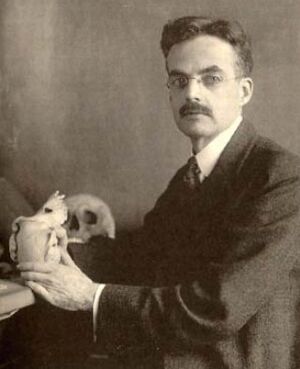William King Gregory facts for kids
Quick facts for kids
William King Gregory
|
|
|---|---|
 |
|
| Born | May 19, 1876 |
| Died | December 29, 1970 (aged 94) |
| Education | Columbia University |
| Known for | Expert on mammalian dentition |
| Spouse(s) |
|
| Awards | National Academy of Sciences |
| Scientific career | |
| Fields | Zoology |
| Institutions | American Museum of Natural History, Columbia University |
| Thesis | The Orders of Mammals (1910) |
| Doctoral advisor | Henry Fairfield Osborn |
| Doctoral students |
|
| Author abbrev. (zoology) | Gregory |
William King Gregory (born May 19, 1876 – died December 29, 1970) was an important American zoologist. He was known for studying primates (like monkeys and apes), fossils (paleontology), and how animal bodies work (anatomy). He was a top expert on mammal teeth and helped shape ideas about evolution. Gregory also shared his knowledge with students and the public through books and museum displays.
Contents
Early Life and Education
William King Gregory was born in Greenwich Village, New York, on May 19, 1876. His parents were George and Jane King Gregory. He went to Trinity School and then started at Columbia University in 1895. He first studied mining but soon switched to zoology.
At Columbia, he focused on zoology and the study of ancient vertebrate animals. His main teacher was Henry Fairfield Osborn. While still a student, Gregory became Osborn's research helper. He earned his first degree from Columbia in 1900. He later received his master's degree in 1905 and his doctorate in 1910.
A Career in Science
William Gregory was interested in many animals, from fishes to land animals. He wrote scientific papers about both groups. By 1911, he also began studying amphibians, like frogs and salamanders. He even wrote about the leg structure of an ancient amphibian called Eryops.
Despite his busy research, he also worked as an editor. He edited the American Museum Journal, which later became Natural History magazine. In 1911, he officially joined the scientific team at the American Museum of Natural History. He also started teaching at Columbia University in 1916. He eventually became a top professor in the Zoology Department.
Studying Animal Evolution
Gregory's main focus was comparative anatomy. This means he compared the body parts of different animals. He believed that the body structures of fossil animals and living animals should show how they are related through evolution. His work explored how animals evolved, from early fishes to birds and mammals. He wrote two major books about this: Our Face from Fish to Man (1929) and Evolution Emerging (1951).
Habitus and Heritage Theory
Gregory developed an idea called habitus and heritage. He thought animals evolved with two types of features. Heritage features came from a long history of evolution. Habitus features were new adaptations that helped animals live in their specific environments.
He later expanded this idea into his palimpsest theory. This theory suggested that habitus features often covered up the older heritage features. Another similar idea, called mosaic evolution, has been developed since Gregory's time.
Focus on Mammals and Humans
Gregory studied lemurs and other insect-eating primates. He always looked for their evolutionary origins. In the 1920s, he became interested in marsupials, like kangaroos. In 1947, he used his palimpsest theory to show a link between monotremes (like platypuses) and early reptiles.
Around the early 1920s, he also became very interested in human evolution. This was especially true after early human-like fossils were found in Africa. Because he was an expert on mammal teeth, he applied this knowledge to human evolution. He became a world leader in understanding how human teeth evolved. His book, The Evolution of the Human Dentition (1922), helped confirm his reputation. However, he did initially believe that the Piltdown Man fossil, which was later found to be a fake, was real.
Gregory was recognized for his work by being elected to important scientific groups. He joined the American Philosophical Society in 1925 and the American Academy of Arts and Sciences in 1931.
Later Life and Legacy
William King Gregory retired from the American Museum of Natural History in 1944. He retired from Columbia University in 1945. He then moved to his home in Woodstock, New York. He lived there with his second wife, Angela, whom he married after his first wife, Laura, passed away in 1937.
In 1949, he received the Viking Fund Medal for his important work in physical anthropology. He died at his home in Woodstock on December 29, 1970. He had been elected to the United States National Academy of Sciences in 1927. At the time of his death, he was one of the oldest members of this respected group.

